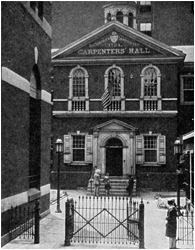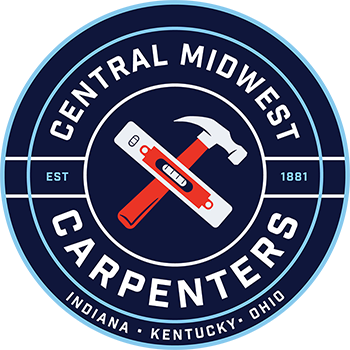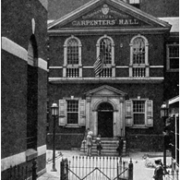 In August 1881, 36 carpenters from eleven cities met in a Chicago warehouse to form a national union. Four days of heated discussion produced a constitution, a structure, and a new organization with two thousand members—the Brotherhood of Carpenters and Joiners of America.
In August 1881, 36 carpenters from eleven cities met in a Chicago warehouse to form a national union. Four days of heated discussion produced a constitution, a structure, and a new organization with two thousand members—the Brotherhood of Carpenters and Joiners of America.
The founding of the union was a response to changing conditions in the construction industry in the second half of the 19th century. The old ways of building were disappearing as a new “modern” system emerged.
Shifts in the larger economic order transformed the daily life of the working carpenter. Facing turbulent times and an uncertain future, carpenters turned to unionism to serve their collective interests.
The carpenter in colonial America had been a man with considerable bargaining power. As one of a small number of skilled artisans in a young society eager for new houses, commercial buildings, and wooden ships, he often earned more than twice as much as his English counterpart.
The carpenter who carried his tools across the Atlantic also brought with him the European “guild system” in which the categories of workers encompassed masters, journeymen, and apprentices. Each handled the tools of the trade in a centuries-old division of work responsibilities. The rules were unwritten, but tradition held that masters looked out for the long-term welfare of journeymen and the training of apprentices, as they passed on the “art” and “mystery” of the craft to the next generation. The division between the groups was not one of permanent status, but of age, years of experience, and levels of skill.
Barring unforeseen circumstances, an apprentice who stayed with the trade could expect, in time, to become a master. To the extent that masters, journeymen, and apprentices shared a common work experience and vision of the industry, their economic interests tended to coincide. Early efforts at organization focused on stabilizing prices and reducing competition between carpenters, not employer/employee conflicts. In the 1700s, master and journeymen carpenters united in most American cities to establish “books of prices,” volumes that standardized the costs of every aspect of the carpentry trade.
As the Industrial Revolution unfolded in the United States, the guild system gave way to a capitalist set of relations in the building industry. The dramatic increase in post-Civil War construction activity outpaced the ability of the masters to meet the labor demands. The volume of building activity shot up 250 percent between 1866 and 1906, an upsurge that included wild swings of phenomenal expansion and terrifying crashes. The dizzying pace of new construction was part of a nation in change. Railroads connected once remote towns and villages. Technological innovations wiped out entire handicrafts and introduced the factory system to growing numbers of industries. The United States emerged from a sea of self-contained communities to a unified country linked by communication and transportation systems.
Mechanical inventions and new building materials altered the carpenter’s work. Factories with new machines—cut-off saws, mortising and tenoning machines, borers, compound carvers, and power sanders—enabled the mass production of items such as blinds, doors, flooring, and stairs that had been fashioned by hand. Cast-iron replaced wood beams as early as 1852 and, by the end of the century, the introduction of structural steel reinforced concrete, and the elevator laid the groundwork for the modern skyscraper.
But the industry changed in other ways as well. The opportunities for profit generated by economic growth attracted speculators and middle men with little or no attachment to the traditions of the industry. These men seized the opportunities created by escalating construction demand but remained ignorant of the issues of craft pride and quality that characterized the guild system. “Jerry” building and “botch” work were frequently the by-products of the new breed of builders who emphasized speed, productivity, and profitability.
The emergence of the contractor/businessman strained the personal connections that had existed between masters, journeymen, and apprentices. At one time, a carpenter might have worked for a single master for twenty years; by the late 1800s, he might have as many as twenty employers in one year.
At the turn of the century, Connecticut carpenter J.W. Brown looked back at the five decades of his trade. He recalled the times when his employer “felt himself under a moral obligation” to the working carpenter and his steady employment. Now, reported Brown, the carpenter had become “accustomed to look upon himself not only as a wage worker for life, but as an appendage to a monstrous machine for the production and distribution of wealth.”
 Gov. Pat McCrory of North Carolina signed an executive order directing state officials to find and penalize employers committing payroll fraud. The EO comes after a News & Observer series detailed the rampant problem and the failure of the legislature to pass anti-payroll fraud bills. Payroll fraud costs North Carolina and the federal government $467 million a year in lost revenue.
Gov. Pat McCrory of North Carolina signed an executive order directing state officials to find and penalize employers committing payroll fraud. The EO comes after a News & Observer series detailed the rampant problem and the failure of the legislature to pass anti-payroll fraud bills. Payroll fraud costs North Carolina and the federal government $467 million a year in lost revenue.


 In August 1881, 36 carpenters from eleven cities met in a Chicago warehouse to form a national union. Four days of heated discussion produced a constitution, a structure, and a new organization with two thousand members—the Brotherhood of Carpenters and Joiners of America.
In August 1881, 36 carpenters from eleven cities met in a Chicago warehouse to form a national union. Four days of heated discussion produced a constitution, a structure, and a new organization with two thousand members—the Brotherhood of Carpenters and Joiners of America.